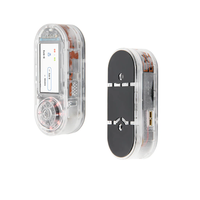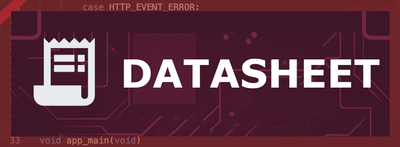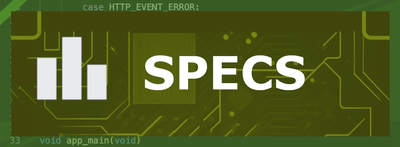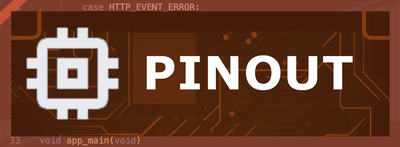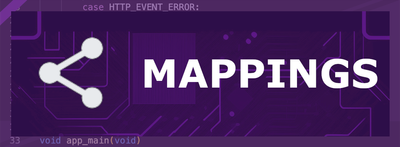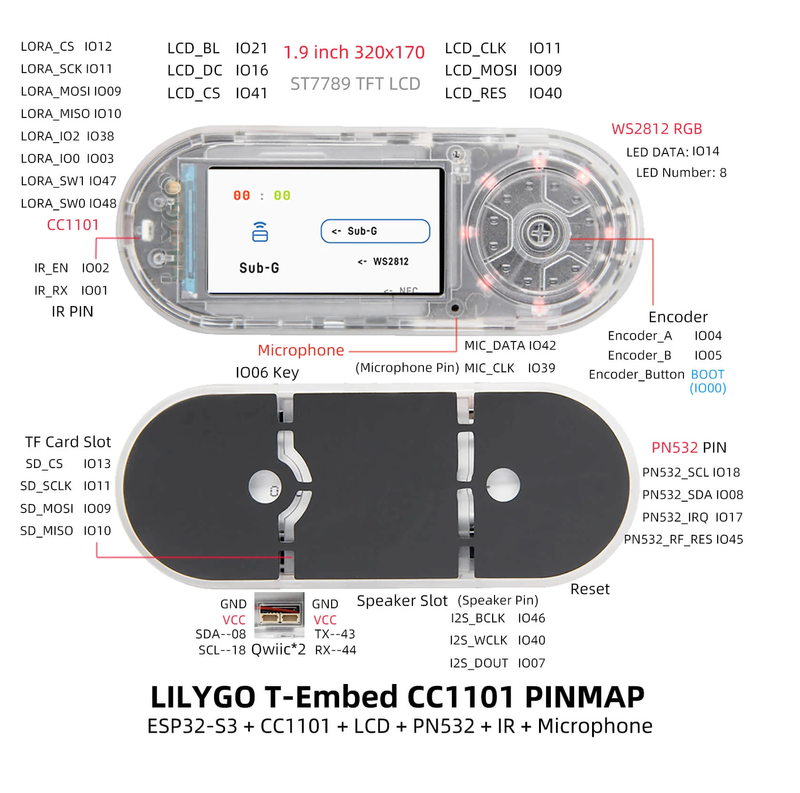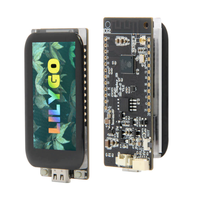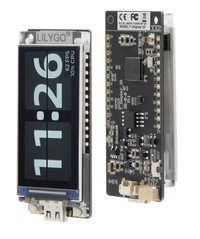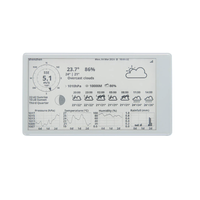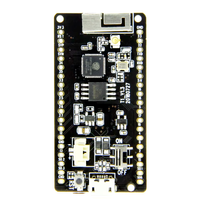LilyGo T-Embed CC1101 Development Board Pinout and Technical Specifications
Code name: LILYGO_T_EMBED_CC1101
Manufacturer: LilyGo
LilyGo T-Embed CC1101 development board is based on esp32s3 microcontroller and uses xtensa architecture. This development board has a maximum CPU frequency of 240 MHz and a flash size of 16MB.
📝 LilyGo T-Embed CC1101 Description
🚀 The LilyGo T-Embed CC1101 is an advanced development board featuring an ESP32-S3 microcontroller with integrated WiFi and Bluetooth 5 capabilities. It includes the CC1101 RF transceiver, enabling sub-1GHz wireless communication, ideal for IoT applications requiring long-range and low-power connectivity. ⚡
📊 LilyGo T-Embed CC1101 Specs
Below you can find the specifications of LilyGo T-Embed CC1101, such as features, connectivity options, and LilyGo T-Embed CC1101 technical specs.
✨ Features
- 48 digital IO pins
- 46 external interrupt pins
- 20 analog input pins
- 27 PWM pins
🖥 Display
- Type: LCD
- Size: 1.54"
- Resolution: 170x320
🖥️ Display
- Type: LCD
- Size: 1.54"
- Resolution: 170x320
🛰️ Connectivity
- WiFi: 802.11 b/g/n (2.4 GHz)
- Bluetooth: 5.0
- BLE: 5.0
📐 Technical specs
| Microcontroller | esp32s3 |
| Clock Speed | 240 MHz |
| Flash size | 16MB |
| PSRAM Size | 8MB |
| Architecture | xtensa |
⚠️ Pins to Avoid or Use with Caution
Some pins are reserved for critical functions like bootstrapping, JTAG debugging, USB communication, and flash memory operations. Misusing these pins may lead to boot failures, programming issues, USB conflicts, or disruptions in flash storage. Below is a list of pins to avoid or use with caution, categorized for clarity:
- 🛠️ Strapping Pins (Boot Mode & System Behavior) - These pins control boot behavior and flash voltage selection. Pulling them high or low at reset can impact boot mode selection, voltage settings, or debugging access. Avoid altering their state unless necessary.
- 🔗 JTAG Debugging Pins - JTAG is used for low-level debugging and programming. If JTAG is enabled, these pins must remain dedicated to it. Repurposing them as GPIO can disable JTAG debugging features.
- 🔌 USB Communication Pins - These pins are used for USB Serial/JTAG communication. If USB debugging or communication is required, they should not be reassigned as GPIO.
- ⚡ Flash Memory & SPI Pins - Certain GPIOs are hardwired to SPI flash memory and PSRAM. Using them as standard GPIOs may result in system instability, corrupted storage, or boot failure.
- 📡 UART Serial Communication Pins - By default, these pins are used for serial debugging, console output, and firmware uploads. Repurposing them for general I/O may break UART programming or debugging capabilities.
| PIN | Label | Reason | Function |
|---|---|---|---|
| IO3 | GPIO3 | Sampled at reset to select JTAG interface (USB Serial/JTAG controller vs. external pins). Improper use can disable external JTAG or alter debug interface. | 🛠️ Strapping |
| IO10 | FSPICS0 | Used to select the external flash chip. It is required for flash access and cannot be repurposed without losing flash connectivity | ⚡ Flash |
| IO11 | FSPID | Used as a data line for flash (and in-package PSRAM). It should not be used as GPIO when the flash/PSRAM is in use. | ⚡ Flash |
| IO12 | FSPICLK | Drives the flash (and PSRAM) clock. This critical signal must be reserved for memory and not used as general GPIO. | ⚡ Flash |
| IO13 | FSPIQ | Used as a data line for flash/PSRAM transfers. Not available for other uses when flash/PSRAM is connected. | ⚡ Flash |
📌 Key Takeaway:
- Before using any GPIO, check if it is assigned a critical function.
- Avoid using bootstrapping pins unless you're modifying boot behavior intentionally.
- If JTAG debugging is needed, ensure its pins remain free.
- USB and Flash-related GPIOs should remain dedicated unless you disable their default functions.
✅ Pins Safe to use
- 🔹 IO1
- 🔹 IO2
- 🔹 IO16
- 🔹 IO17
- 🔹 IO18
- 🔹 IO21
- 🔹 IO22
- 🔹 IO23
Unlike restricted pins, these GPIOs are not tied to essential system functions like 🛠️ bootstrapping, 🔌 USB communication, 🔗 JTAG debugging, or ⚡ SPI flash memory, making them the best choices for custom applications and general use.
Why Are These Pins Safe?- Not involved in bootstrapping → These GPIOs do not affect the device’s boot mode or system startup.
- Not linked to flash memory or PSRAM → They won’t interfere with storage or memory access.
- Not dedicated to USB or JTAG → They remain free for general use without affecting debugging or programming.
- No special hardware connections → Unlike some pins that are internally wired to system functions, these remain freely assignable.
🗺️ LilyGo T-Embed CC1101 External Pins Mapping Functions
Below you can find the LilyGo T-Embed CC1101 pinout. This development board provides 48 digital IO pins, out of which 46 can be used as an external interrupt pins , 20 as analog input pins and 27 pins have Pulse-Width Modulation (PWM) .
| Pin | Function | ESP Pin | Input/Output | Description |
|---|---|---|---|---|
| 1 | 3V3 | 3.3V | POWER OUTPUT | 3.3V power output |
| 2 | GND | GND | POWER GROUND | Ground connection |
| 3 | 5V | 5V | POWER INPUT | 5V power input |
| 4 | IO1 | GPIO1 | BIDIRECTIONAL | GPIO, ADC, I2C |
| 5 | IO2 | GPIO2 | BIDIRECTIONAL | GPIO, ADC |
| 6 | IO3 | GPIO3 | BIDIRECTIONAL | GPIO, ADC |
| 7 | IO10 | SPI_CS | BIDIRECTIONAL | GPIO, SPI Chip Select |
| 8 | IO11 | SPI_D | BIDIRECTIONAL | GPIO, SPI Data |
| 9 | IO12 | SPI_CLK | BIDIRECTIONAL | GPIO, SPI Clock |
| 10 | IO13 | SPI_Q | BIDIRECTIONAL | GPIO, SPI Q |
| 11 | IO16 | CC1101_CS | OUTPUT | GPIO, CC1101 Chip Select |
| 12 | IO17 | CC1101_GDO0 | INPUT | GPIO, CC1101 Interrupt |
| 13 | IO18 | CC1101_GDO2 | INPUT | GPIO, CC1101 Status |
| 14 | IO21 | LCD_DC | OUTPUT | GPIO, LCD Data/Command |
| 15 | IO22 | LCD_RST | OUTPUT | GPIO, LCD Reset |
| 16 | IO23 | LCD_BL | OUTPUT | GPIO, LCD Backlight |
🛠️ Default Tools
| Bootloader tool | esptool_py |
| Uploader tool | esptool_py |
| Network uploader tool | esp_ota |
| Bootloader address | 0x0 |
| Flash mode | dio |
| Boot mode | qio |
| PSRAM type | opi |
| Maximum upload size | 3072 Kb (3145728 B) |
| Maximum data size | 320 Kb (327680 B) |
The LilyGo T-Embed CC1101 development board by default uses esptool_py uploader tool, esp_ota network uploader tool for Over-the-air (OTA) uploads and esptool_py bootloader tool. The bootloader starts at address "0x0". Flash mode and boot mode for LilyGo T-Embed CC1101 development board by default is dio and qio respectively. The board uses opi PSRAM type. When using Arduino IDE, the maximum sketch upload size is 3072 Kb (3145728 B) and maximum data size for variables is 320 Kb (327680 B).

